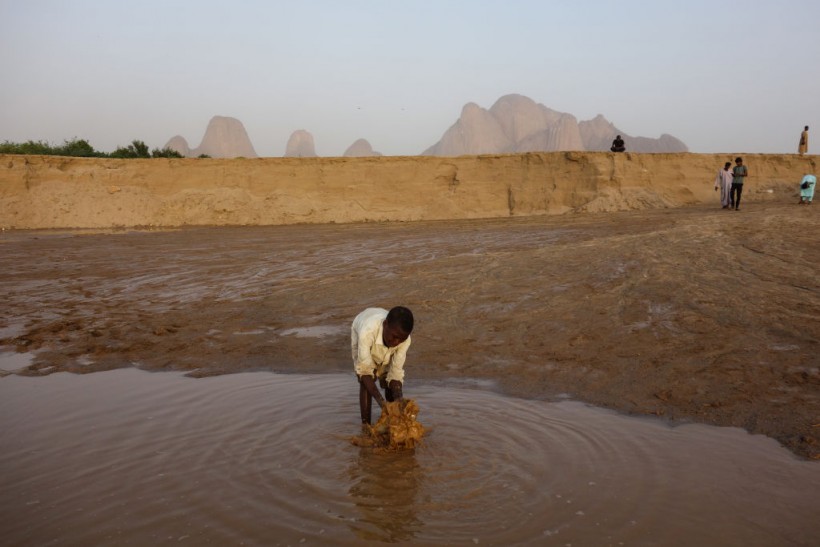
Zoology
Zoology is the scientific study of animals, encompassing topics related to the biology, behaviour, structure, evolution, classification, and distribution of animals.
Zoology is the scientific study of animals, encompassing topics related to the biology,... View more
Sudanese Communities Face Harsh Realities as Water Becomes Scarce in War-Torn Regions
-
Sudanese Communities Face Harsh Realities as Water Becomes Scarce in War-Torn Regions
Amidst the backdrop of political turmoil and the echoes of conflict, Sudan is grappling with a devastating water crisis.
The country’s plight is a confluence of war-induced infrastructure damage, ecological challenges, and climatic extremities, all of which have conspired to create a perfect storm of scarcity and suffering.
The Human Cost of Water Scarcity

(Photo : AFP via Getty Images) The water crisis in Sudan has reached alarming levels, with the Sortoni displacement camp in North Darfur serving as a grim reminder of the severity of the situation.
Families like Issa’s, who reside in the camp, face a daily ordeal of walking 14 kilometers to secure water for their basic needs.
This arduous journey is necessitated by the ongoing conflict between Sudan’s army and the paramilitary Rapid Support Forces (RSF), which has led to the withdrawal of most foreign aid groups that previously operated local water stations.
The siege of El-Fasher, the capital of North Darfur, has further exacerbated the crisis, leaving over 800,000 civilians without access to water.
The Golo water reservoir, which serves as a lifeline for approximately 270,000 people, is now under threat due to the ongoing clashes.
The United Nations has urgently called for an end to the siege, emphasizing the dire humanitarian implications.
A Struggle for Resources Amidst Conflict
The roots of Sudan’s water crisis extend deep into the country’s history, well before the current war. Even then, a quarter of the population had to undertake long journeys to access water.
Today, the crisis has intensified, with the US ambassador to the United Nations describing Sudan as facing “the largest humanitarian crisis on the face of the planet”.
The struggle for water and other resources has been a longstanding issue in Sudan. The absence of fuel to operate water stations has left many areas on the brink of an acute water shortage.
In the village of Shaqra, where 40,000 people have sought refuge, residents queue for hundreds of meters for drinking water.
The international community has taken notice of Sudan’s plight, but the situation remains critical. As temperatures rise and resources dwindle, the resilience of the Sudanese people is tested like never before.
Also Read: US Facing Dire Water Scarcity on its Biggest Freshwater Reserves, Says New Study
What are the Root Causes of Sudan’s Water Crisis?
The root causes of Sudan’s water crisis are multifaceted and stem from a combination of ecological, political, and social factors:
Ecological Challenges:
Sudan is facing ecological crises like water scarcity and desertification. The country’s inhabitants are often displaced by changing landscapes and a lack of agricultural production, which is exacerbated by droughts and floods.
Climate Change: Increasing floods and droughts due to variable rainfall, exacerbated by climate change, have put additional pressure on an agricultural system already strained by underinvestment and limited water storage infrastructure.
Political Instability:
Chronic political instability and widespread conflict have hindered attempts at institutional reform, impacting the management of water resources and infrastructure development.
Resource Management:
About 70 percent of farmers rely on rainfed farming, and the agricultural sector, which employs over 70 percent of the workforce, is in a fragile state due to drought, lack of investment, and increasing population density.
Infrastructure Deterioration: The water supply and sanitation sector is fraught with problems, including deteriorated irrigation schemes due to inefficiencies, aging infrastructure, low crop yields, and poor management.
Economic Strain:
The secession of South Sudan in 2011 strained the economy, and the ethnic and social conflicts have burdened successive governments, making it difficult for the country to break free from its resource curse.
Service Delivery Issues: Over 40 percent of households in Sudan do not have access to basic water services, and the functionality of the overall water facility system sits at about 73 percent.
These factors, combined with the ongoing conflicts within Sudan’s military government, have significantly impacted the lives of thousands of Sudanese citizens, making basic amenities like water inaccessible for many.
The situation is critical, and efforts are needed to rebuild and implement significant institutional and legislative reforms to address these root causes effectively.
Related article: Water Scarcity Looms Large: Climate Change and Development Threaten Global Water Security
© 2024 NatureWorldNews.com All rights reserved. Do not reproduce without permission.
Sorry, there were no replies found.
Log in to reply.
